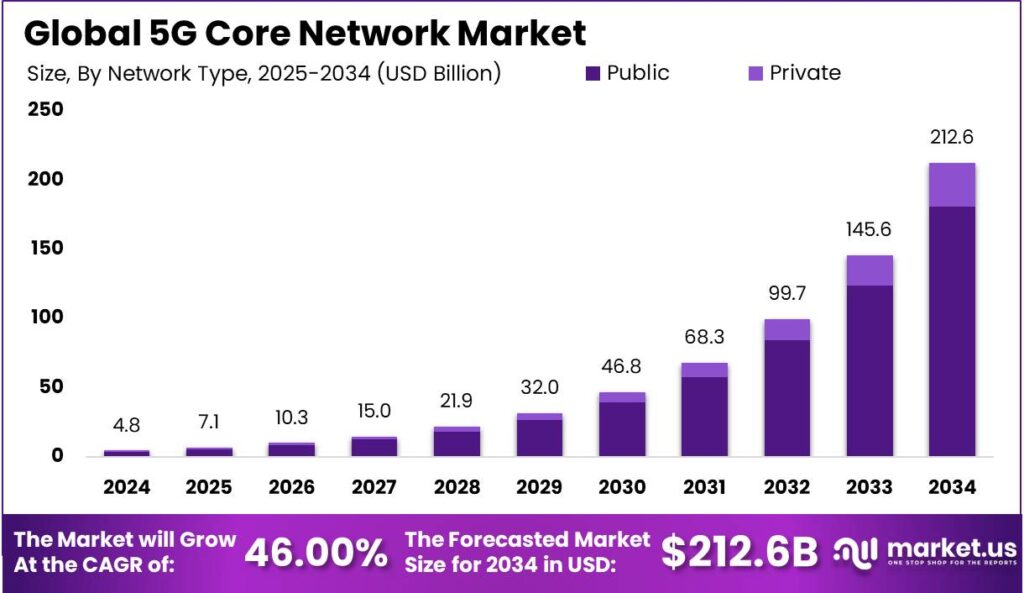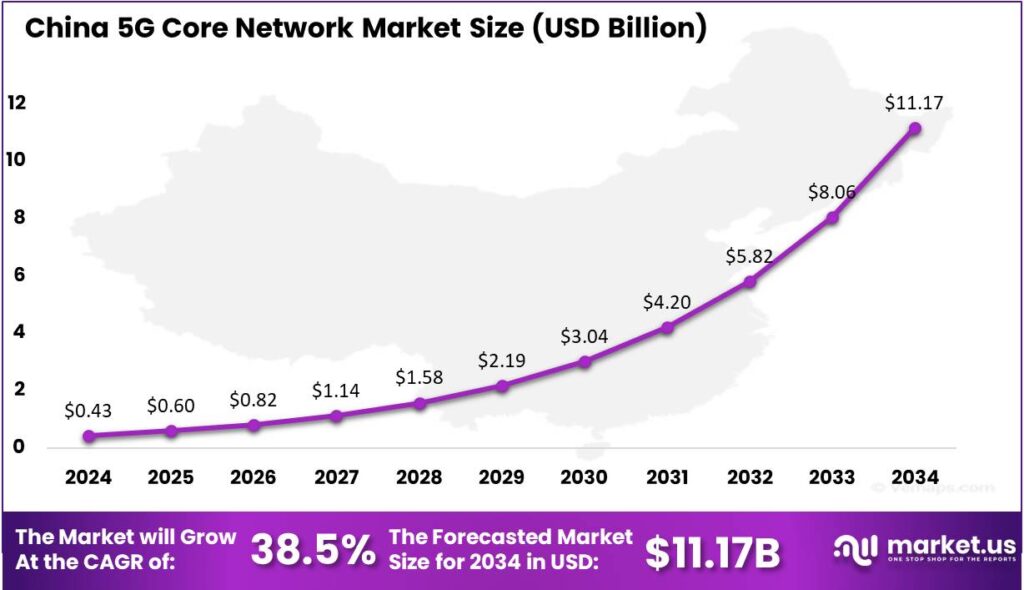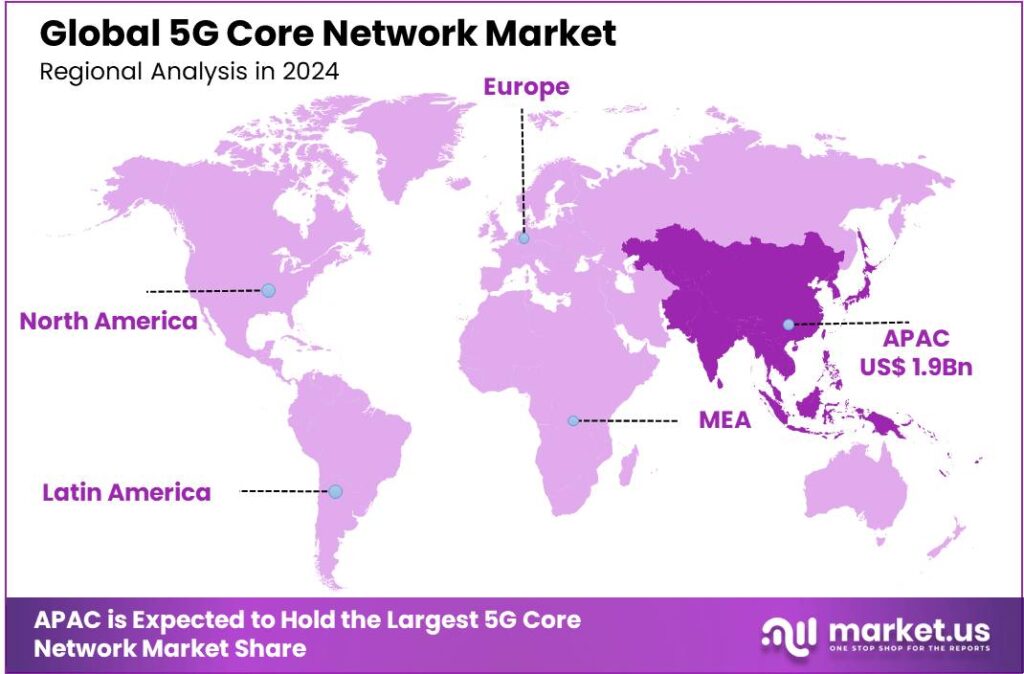Table of Contents
Report Overview
According to Market.us, By 2034, the Global 5G Core Network Market is projected to reach an impressive USD 212.6 billion, soaring from just USD 4.83 billion in 2024. This remarkable growth, driven by a compound annual growth rate (CAGR) of 46.00%, highlights the rapid expansion of the sector over the next decade. In 2024, the Asia-Pacific region is leading the charge, accounting for 40.3% of the market share and generating USD 1.9 billion in revenue.
The 5G Core Network, commonly abbreviated as 5GC, is an integral component of the fifth-generation mobile network. Unlike its predecessors, the 5G Core is engineered entirely on a software-based, service-centric framework which boosts flexibility and scalability. This architecture supports a broad spectrum of advanced functionalities required for next-gen telecommunications, such as enhanced mobile broadband, ultra-reliable low-latency communications, and massive machine-type communications.
The market for 5G Core networks is propelled by the growing demand for high-speed, reliable internet service that supports an increasing number of connected devices. As 5G technology enables unprecedented connectivity speeds and more reliable network performance under high demand, industries across various sectors (from manufacturing to healthcare) are keen to integrate 5G capabilities into their operations.

The expansion of the 5G Core Network market is majorly driven by the need for more efficient network management systems that can handle increased data traffic and support diverse applications. With the rise of IoT (Internet of Things), there is a pressing need for networks that can efficiently process vast amounts of data in real-time. Additionally, the push towards digital transformation by businesses and the increasing consumption of video content are also significant contributors to this demand.
Market demand for 5G Core networks is closely tied to the broader adoption of 5G technology worldwide. As more countries and regions invest in upgrading their telecom infrastructure to support 5G, the demand for advanced core networks that can leverage 5G’s capabilities increases. This offers substantial opportunities for network equipment manufacturers, service providers, and software developers to innovate and expand their market presence. Additionally, the emergence of smart cities, automated industries, and advanced healthcare systems reliant on robust 5G networks presents further growth opportunities.
Technologically, the 5G Core Network is at the forefront of several innovations. These include the use of cloud-native technologies, network function virtualization (NFV), and software-defined networking (SDN), which contribute to the core’s agility and scalability. Further advancements such as edge computing are being integrated to reduce latencies and enhance the performance of applications that require real-time processing. The ongoing development in AI and machine learning also promises to optimize network operations and user experiences through more sophisticated data analytics.
Key Takeaways
- The Global 5G Core Network Market is projected to reach USD 212.6 Billion by 2034, growing from USD 4.83 Billion in 2024, at a CAGR of 46.00% from 2025 to 2034.
- In 2024, the Solutions segment dominated, capturing over 81.2% of the market share, driven by core network solutions like NFV, SDN, and key technologies for 5G deployment.
- The Cloud-Based segment held a leading position in 2024 with more than 61% market share.
- The Non-Standalone (NSA) segment led the market in 2024, with more than 60% of the market share.
- The Public segment commanded over 85% of the market share in 2024.
- Telecom Operators held the largest share in 2024, with over 65% of the 5G Core Network market.
- The Asia-Pacific region accounted for 40.3% of the market share in 2024, generating USD 1.9 Billion in revenue.
- The 5G Core Network market in China, valued at USD 0.43 Billion in 2024, is expected to grow rapidly with a 38.5% CAGR in the coming years.
Analyst’s Viewpoint
Investment Opportunities & Risks
The 5G core network market is ripe with investment opportunities, primarily driven by the rapid expansion of connected devices and the global surge in data traffic. As industries like telecommunications, manufacturing, and healthcare increasingly rely on high-speed and reliable internet connectivity, the demand for advanced 5G core network solutions grows, presenting significant investment opportunities. However, investors must also consider several risks, including high initial infrastructure costs and potential regulatory changes that could affect deployment and operation costs. The market’s competitive intensity is another factor, as companies vie for market share in a rapidly evolving tech landscape
Consumer Insights & Technological Impact
Consumers and enterprises are increasingly seeking technologies that provide seamless connectivity and support for applications requiring low latency and high data throughput. The 5G core network caters to these needs by enabling advanced applications like augmented reality (AR), virtual reality (VR), and IoT devices. The integration of edge computing with 5G networks is particularly noteworthy, enhancing network efficiency and reducing latency, which is crucial for real-time applications.
Regulatory Environment
The deployment of 5G networks also faces challenges from the regulatory environment, which varies significantly across regions. Compliance with these regulations can be costly and time-consuming, potentially slowing down deployments. Additionally, the allocation of spectrum and concerns about cybersecurity and data privacy remain pivotal regulatory hurdles that could impact the pace of 5G adoption. On the upside, some governments are actively supporting the rollout of 5G, which could mitigate some of these challenges and foster a more conducive environment for growth.
Impact Of AI
- Improved Network Efficiency and Automation: AI can help manage and optimize the 5G network in real-time. It automates tasks like traffic management, load balancing, and fault detection, making the network more efficient and reducing the need for manual intervention. This means better use of resources, quicker problem-solving, and a smoother overall network experience.
- Enhanced Network Security: AI improves security by detecting unusual activities that could indicate a cyber attack or breach. It can spot patterns that humans might miss and take action faster, such as blocking malicious traffic or isolating threats. AI-powered systems can continuously monitor the 5G core network and react instantly to potential risks.
- Improved Quality of Service (QoS): With AI, network providers can predict and adjust the quality of service for users based on real-time data. For instance, AI can automatically allocate more bandwidth during high-demand periods, ensuring a better experience for users. It can also help prioritize critical applications, like healthcare or emergency services, ensuring these remain uninterrupted.
- Faster Network Deployment and Expansion: AI can significantly speed up the deployment of new 5G core network infrastructure. By analyzing geographic data and predicting where demand will be highest, AI helps operators make informed decisions on where to expand coverage and deploy new cells. This reduces the time and costs involved in building out the network.
- Improved Customer Experience: AI enables more personalized services for users. It can analyze how users interact with the network and optimize their experience by customizing settings, speeds, and services. AI-driven chatbots or virtual assistants can also help with customer support, providing quick and efficient answers to common issues without human intervention.
China Market Size and Growth
The market for 5G Core Networks in China, valued at US$ 0.43 billion in 2024, is poised for significant growth in the coming years. With the rapid expansion of 5G infrastructure across the country, China is positioning itself as a global leader in the adoption of 5G technology. The market is expected to experience an impressive compound annual growth rate (CAGR) of 38.5%, indicating a robust demand for advanced network solutions and infrastructure upgrades.
The rapid expansion of the 5G core network market in China is driven by the growing demand for faster, more reliable connectivity. As telecom providers roll out 5G to support IoT, smart cities, and autonomous vehicles, advanced core network solutions become crucial. China’s push for digital transformation and government initiatives are further accelerating growth, creating new business opportunities in the telecom sector.

In 2024, the Asia-Pacific region emerged as the dominant force in the 5G Core Network market, commanding a substantial market share of over 40.3%. With a revenue of USD 1.9 billion, the region is leading the global charge in the development and deployment of 5G core infrastructure. This dominance can be attributed to a combination of factors, including significant investments in telecommunications infrastructure, favorable government policies, and the rapidly growing demand for high-speed connectivity across various sectors.
Several countries within the Asia-Pacific region, notably China, South Korea, and Japan, are at the forefront of 5G adoption. These nations have already made considerable strides in 5G rollout, with China in particular investing heavily in the expansion of both its 5G network and related core technologies.
Government initiatives, such as funding for 5G research and development and the encouragement of industry collaborations, have played a key role in accelerating the growth of the 5G core network market. Additionally, the region’s strong manufacturing and technology sectors, which rely heavily on high-speed, low-latency networks for automation, Internet of Things (IoT), and smart manufacturing, are further driving demand for 5G infrastructure.

Emerging Trends
- Open RAN (Radio Access Networks): This trend is driving more flexibility and cost efficiency in 5G deployments by encouraging open and interoperable standards. This allows for a greater diversity of vendors and innovation in network development.
- Network Slicing: A key trend that enables multiple virtual networks to operate on the same physical infrastructure, tailored for specific needs and applications. This enhances efficiency and allows for customized network capabilities.
- Edge Computing: Integrating edge computing with 5G networks reduces latency and improves real-time data processing, crucial for applications such as autonomous vehicles and smart city technologies.
- Enhanced Security: As 5G networks become more integral to infrastructure, enhanced security features including advanced encryption and real-time threat detection are becoming standard to protect against cyber threats.
- Cloud-Native Networks: The shift towards cloud-native architectures using microservices and containers allows for greater scalability and agility in network management and service deployment.
Top Use Cases
- Enhanced Mobile Broadband (eMBB): This use case focuses on providing significantly faster data speeds and greater capacity, catering to the increasing demand for high-resolution video streaming and immersive virtual reality applications.
- Ultra-Reliable Low-Latency Communications (URLLC): Crucial for critical applications such as remote surgery and autonomous driving, where immediate data transfer is essential for operational safety and effectiveness.
- Massive Machine-Type Communications (mMTC): Supports large-scale IoT deployments, enabling vast numbers of sensors and devices to connect and communicate seamlessly, which is vital for smart cities and industrial automation.
- Smart Cities: Utilizing 5G networks to manage everything from traffic and energy use to emergency services and urban infrastructure, improving overall efficiency and quality of life for residents.
- Industrial Automation: 5G facilitates more sophisticated automation and control systems in manufacturing and production processes, enhancing precision and efficiency while reducing operational downtime.
Major Challenges
- High Spectrum Costs: Securing the necessary spectrum for 5G is costly, with prices for 5G spectrum reaching significant amounts worldwide. The high cost of spectrum auctions can make initial investments in 5G prohibitive for some operators.
- Complex Network Infrastructure: Deploying 5G involves intricate network architectures that require substantial modification from traditional networks. This complexity includes integrating advanced technologies like network slicing, massive MIMO, and managing the densification of networks with small cells which are necessary for supporting the mmWave frequencies.
- Integration with Legacy Systems: Ensuring compatibility and smooth transition between existing 4G networks and new 5G systems presents significant technical challenges. This includes maintaining service continuity and quality while deploying new technologies.
- Security Enhancements: With the broader attack surface presented by 5G, enhancing security measures is critical. This involves safeguarding against potential cyber threats and ensuring privacy and data protection across more complex networks.
- Skilled Workforce Shortage: The deployment and maintenance of 5G networks require highly specialized knowledge in new 5G technologies. There is a notable shortage of skilled professionals in the field, which can hinder the pace of deployment and innovation.
Attractive Opportunities
- Enhanced Mobile Broadband (eMBB): 5G will drastically improve mobile broadband services, providing ultra-high data speeds and greater capacity. This enables better consumer experiences with faster downloads and high-quality streaming services.Internet of Things (IoT) Expansion: 5G is crucial for the massive scale deployment of IoT devices due to its ability to support a vast number of connections per square kilometer. This opens opportunities in smart cities, industrial automation, and more.
- Low-Latency Applications: The ultra-low latency of 5G enables real-time applications such as autonomous driving, remote surgeries, and advanced gaming, presenting new markets and revenue streams.
- Private 5G Networks for Enterprises: There is growing interest in private 5G networks from businesses seeking more control over their network infrastructure. This is particularly appealing for mission-critical applications where security, capacity, and latency are key concerns.
- Edge Computing Integration: 5G’s compatibility with edge computing allows data to be processed closer to the source, reducing latency and enhancing the performance of applications that rely on immediate data processing. This is particularly beneficial for applications requiring instant responses such as in manufacturing and public safety.
Top Key Players in the Market
- Ericsson
- Nokia Networks
- Huawei Technologies
- ZTE Corporation
- Cisco Systems
- Samsung Electronics
- Oracle
- NEC Global
- IPLOOK
- HPE
- ENEA
- Intel Corporation
- Juniper Networks
- Mavenir
- Keysight Technologies
- Other Key Players
Market Opportunities for Key Players
- Private 5G Networks for Enterprises: As businesses seek more secure and reliable networks, private 5G networks are becoming increasingly popular. Companies in manufacturing, healthcare, and logistics are investing in dedicated 5G networks to improve operational efficiency, enhance security, and support new applications like autonomous machines. This trend is expected to grow rapidly in the coming years.
- Edge Computing Integration: The integration of edge computing with 5G networks is creating new opportunities. By processing data closer to the source, businesses can reduce latency and improve real-time performance for applications like autonomous driving and smart cities. This will open new revenue streams for companies offering edge computing services alongside 5G core networks.
- Network Slicing for Custom Solutions: 5G’s ability to offer network slicing allows companies to create custom network solutions for specific industries, such as healthcare, entertainment, and industrial automation. This tailored approach enables more efficient use of resources and better service delivery, thus generating new business models and revenue opportunities.
- 5G for IoT Growth: The Internet of Things (IoT) is set to benefit significantly from 5G’s high-speed, low-latency capabilities. From smart cities to connected vehicles, the need for robust 5G infrastructure to support billions of IoT devices is growing. Companies that specialize in 5G core networks have a huge opportunity to support this expansive ecosystem.
- 5G Roaming and Interconnect Services: As 5G networks become more widespread, the demand for seamless roaming and interconnect services will rise. This opens up opportunities for companies to offer solutions that allow users to connect effortlessly across borders and networks, ensuring global 5G interoperability.
Recent Developments
- In March 2024, The merger between Orange and Masmovil was approved by the European Commission, creating a joint venture with over 37 million broadband and mobile lines. This strategic move aims to strengthen their position in the Spanish connectivity market.
- In July 2024, Accenture finalized the acquisition of Fibermind, an Italian company specializing in fiber and mobile 5G network services. This acquisition enhances Accenture’s capabilities in telecommunications network engineering, leveraging automation and AI technologies.
Conclusion
In summary, the 5G Core Network market is poised for significant growth as telecommunications providers and enterprises transition to next-generation technologies. The demand for higher speeds, low latency, and improved connectivity is driving the need for more robust and flexible core network solutions. This transformation is being fueled by advancements in cloud-native architecture, virtualization, and edge computing, which enable efficient and scalable network management.
The market’s expansion is also supported by the rise of new applications, including the Internet of Things (IoT), autonomous vehicles, and Industry 4.0, all of which require reliable, high-performance network infrastructure. As 5G adoption accelerates globally, the core network will play a critical role in supporting diverse use cases and fostering innovation across industries, making it a key focus for telecom operators and technology providers alike.
Discuss your needs with our analyst
Please share your requirements with more details so our analyst can check if they can solve your problem(s)



